The Chromebook Pixel (2015) Review
by Brandon Chester on March 16, 2015 8:00 AM EST- Posted in
- Laptops
- Chrome OS
- Chromebook
- Chromebook Pixel
Display
When the original Chromebook Pixel launched two years ago, its big selling point and the source of its name was its 239ppi 2560x1700 display. At that time, the only other laptops on the market with HiDPI displays were Apple's Retina MacBook Pros. Chromebooks have typically aimed for the low-cost segment of the laptop market, and so it was quite a surprise that one of the earliest HiDPI laptops was a Chromebook. Although the Pixel had the highest pixel density of any laptop display at the time, it fell somewhat short when it came to color reproduction due to its narrow color gamut and lack of calibration. With the new Chromebook Pixel, Google has advertised coverage of the sRGB color gamut, along with a maximum brightness of 400nits.
To see whether or not Google has hit their mark, we turn to our standard display testing workflow. As usual, all measurements are performed using SpectraCal's CalMAN 5 software along with X-Rite's i1Pro 2 spectrophotometer, with the exception of black level measurements which are performed with an i1Display Pro colorimeter.
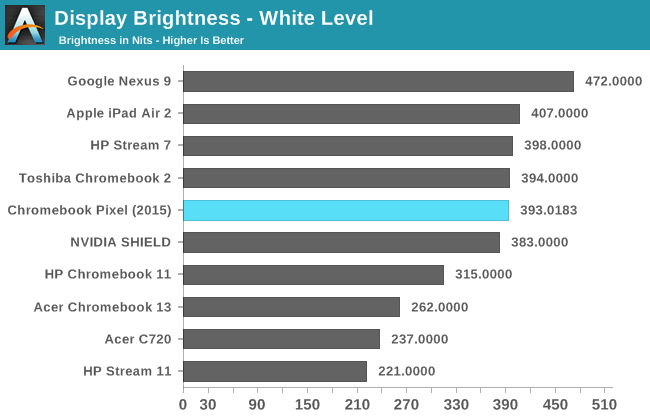
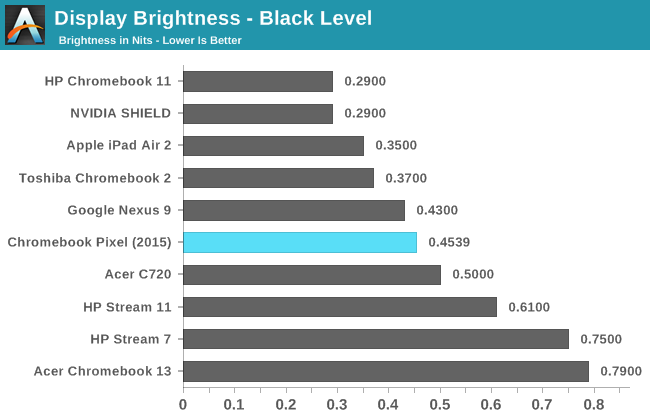
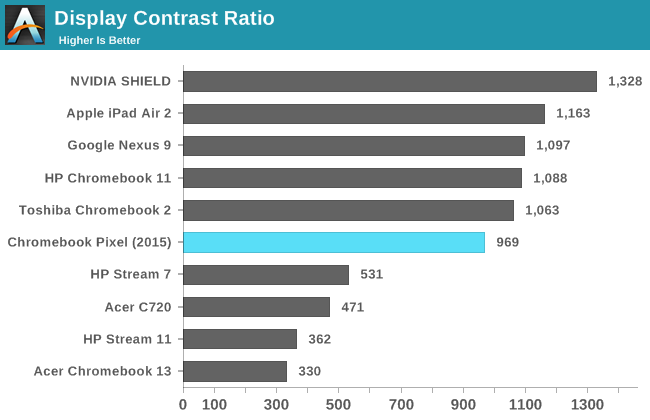
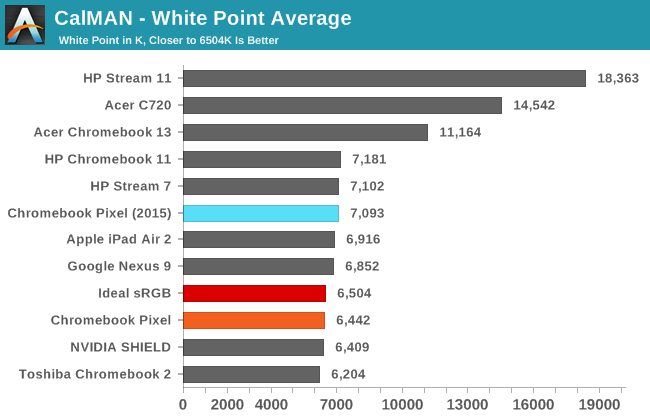
Due to the evolution of our display workflow as time has gone on, I don't have results to compare the new Pixel to the original for certain categories. The result for maximum brightness is certainly in line with Google's advertised 400nit brightness, while the black levels and contrast ratio are what you would expect of IPS panels. The white point is noticeably more blue than the ideal D6504 target, which contrasts with the original Pixel which was very slightly too red. The blue/green tint in white and shades of grey is also more obvious than most other devices with similar average white points, which I elaborate on further below.

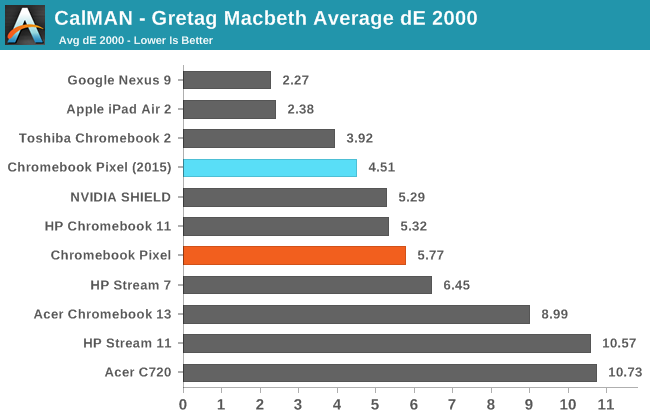
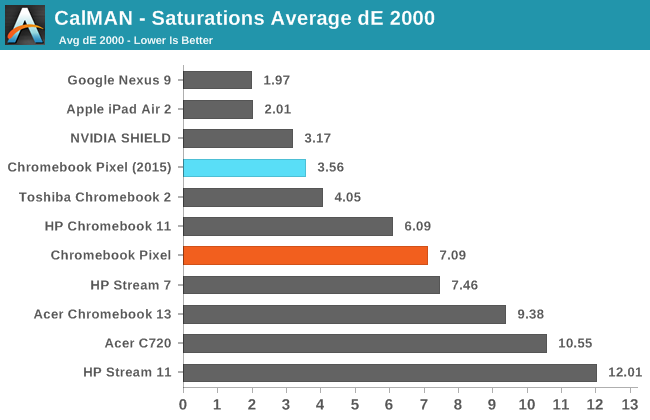
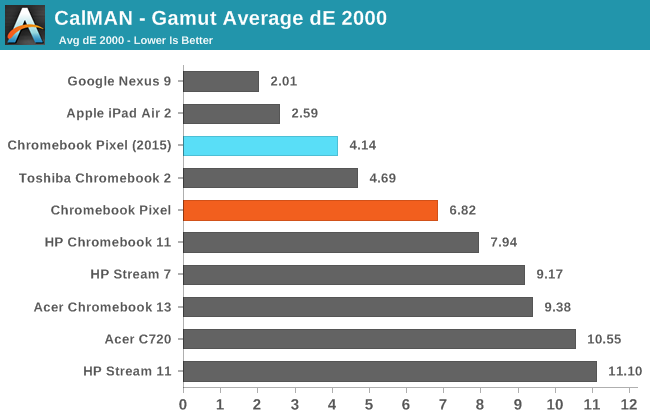
The new Pixel improves significantly upon the original in the gamut and saturation tests. It has a much wider gamut than the original, although it misses in magenta and yellow. Saturation improvements follow the improved gamut, as colors of 80% and 100% saturation no longer look identical. Despite these improvements, there hasn't been much progress on greyscale and color mixture accuracy. As noted earlier, the Pixel has a fairly obvious green/blue tint to the lighter shades of grey and white. As you can see in the gallery below, this is due to the reduction in red and increase in blue components of luminance as the shades of grey move from black to white.
I don't expect that many Chromebook users will be doing heavy photo and video editing that requires a perfectly calibrated display. Many $999 laptops ship with displays that are much worse than the one on the new Pixel, and I think that most users will be very happy with the Pixel's display. It's just a shame that Google doesn't seem to have put the same amount of care into display calibration with the Pixel as they have with the Nexus 9 and other Google branded devices, despite it having the highest price point of the devices they sell.
















123 Comments
View All Comments
jabber - Wednesday, March 18, 2015 - link
I must say if I wasn't in the realm of Windows support I'd dump all my computing gear and buy a Pixel in a heart beat. I have a little 11" Samsung Chromebook and I love it. I must say I'm aghast at the level of ignorance on this and many tech sites regarding the Pixel and ChromeOS in general.uhuznaa - Monday, March 16, 2015 - link
Executive ChromeBook.ATC9001 - Monday, March 16, 2015 - link
Is it possibly to remove the SSD and put in another one and dual boot windows?...or just windows only?999 is decent, add 100/200 for a 256/512 SSD and you get a pretty solid machine for a reasonable price. Would be interesting to see this compared to say an XPS 13 or similiar
edhburns - Monday, March 16, 2015 - link
My assumption is that it is not possible to remove the SSD. The previous version was soldered down. Although I haven't seen any reviews of this device where anyone opened up the inside to find out. So time will tell.chlamchowder - Monday, March 16, 2015 - link
If you're going that route, you might as well get a Surface Pro 3 + type cover for about the same price. You're also guaranteed that the hardware is supported in Windows.iniudan - Monday, March 16, 2015 - link
Cannot boot Windows has they use Coreboot as their boot firmware.Of course if you were willing to load a payload to Coreboot it could be possible, in theory, but you would have to disable Chromebook secure boot first, which is a bit more involved then the UEFI equivalent.
iniudan - Monday, March 16, 2015 - link
And let not forget all the possible driver problem once you boot Windows.Uplink10 - Monday, March 16, 2015 - link
Other Linux distributions clearly beat Chrome OS with their wide range of software and hardware is an overkill for this notebook.chlamchowder - Monday, March 16, 2015 - link
They should put in a 256 GB SSD and ship it without an OS for the same price.cjb110 - Tuesday, March 17, 2015 - link
I think they hope someone else will...Google isn't interested in making PC's. Do we know who made it for Google? Maybe they could be convinced.